Block Island and Beyond:
Offshore Wind in the United States

Block Island and Beyond:
Offshore Wind in the United States


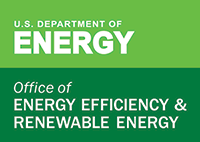
OFFICE OF ENERGY EFFICIENCY & RENEWABLE ENERGY
Four of the five GE Haliade 6-megawatt turbines that make up the Block Island Wind Farm. Photo by Dennis Schroeder, NREL 40447
U.S. DEPARTMENT OF ENERGY
2
Block Island and Beyond: Offshore Wind in the United States
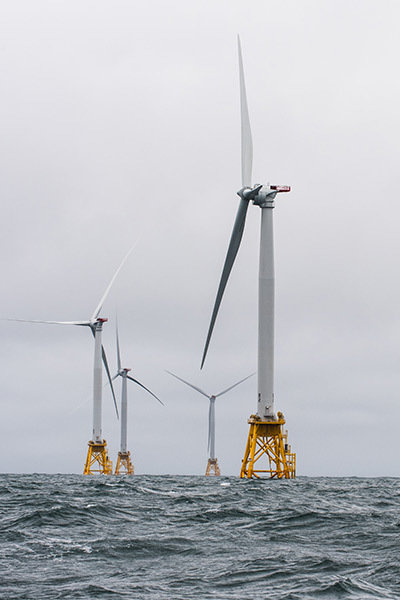
OFFICE OF ENERGY EFFICIENCY & RENEWABLE ENERGY
Global cumulative installed offshore wind capacity grew to 27,064 megawatts (MW) in 2019. The United Kingdom is still the largest offshore wind market with 8,478 MW installed, followed by Germany with 7,441 MW at the end of 2019.
*National Renewable Energy Laboratory, 2020. 2019 Offshore Wind Technologies Market Update.
U.S. DEPARTMENT OF ENERGY
3
Block Island and Beyond: Offshore Wind in the United States
Offshore wind development has expanded globally for the past two decades.
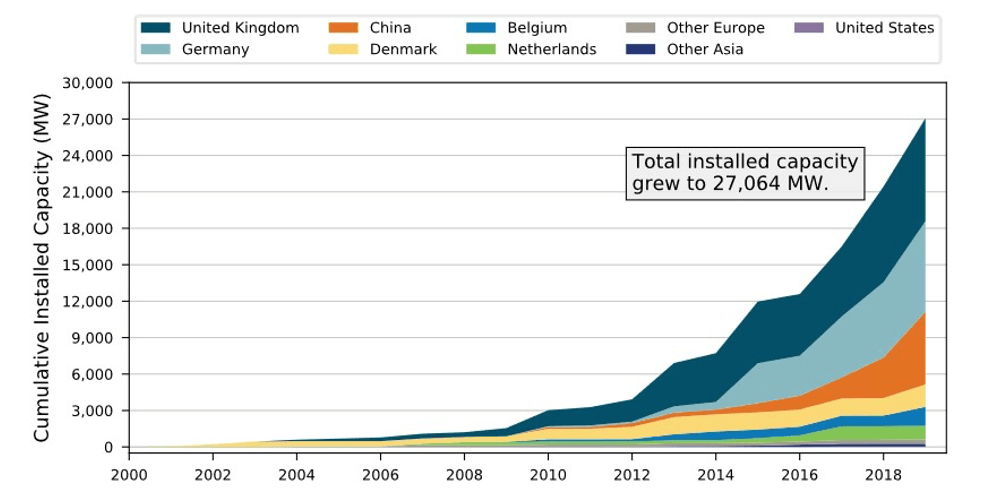
Graph showing global cumulative offshore installed wind capacity and annual offshore wind capacity by market. Illustration from 2019 Offshore Wind Technologies Market Update.
OFFICE OF ENERGY EFFICIENCY & RENEWABLE ENERGY
Completed in 2016, the Block Island Wind Farm is the nation’s first offshore wind farm. Developed by Deepwater Wind and owned by Orsted Offshore North America, the 30-MW project consists of five GE turbines capable of producing the energy needed to power up to 17,000 homes. The project is located in state waters approximately 3 miles off the southeastern coast of Block Island, Rhode Island.
U.S. DEPARTMENT OF ENERGY
Recent milestones highlight the advancement of offshore wind in the United States.
Block Island and Beyond: Offshore Wind in the United States
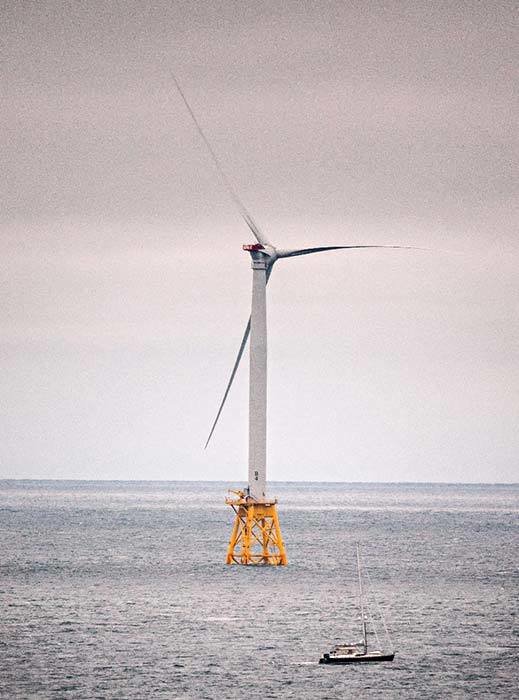
*Orsted Offshore North America. Block Island Wind Farm. Accessed February 17, 2021.
One of the five GE Haliade 6-MW turbines that make up the Block Island Wind Farm. Photo by Dennis Schroeder, NREL 40485
4
OFFICE OF ENERGY EFFICIENCY & RENEWABLE ENERGY
The U.S. offshore wind pipeline grew by 2,697 MW in 2019 to a total capacity of 28,521 MW. The U.S. offshore wind pipeline is broken down as follows:
- 30 MW is operating, which was unchanged in 2019
- 12 MW is under construction
- 6,439 MW is in the permitting stage
- 17,440 MW is under site control
- 4,600 MW is in planning.
U.S. DEPARTMENT OF ENERGY
More offshore wind projects are in various stages of development.
Block Island and Beyond: Offshore Wind in the United States
*National Renewable Energy Laboratory. 2020. 2019 Offshore Wind Technology Data Update.
5
OFFICE OF ENERGY EFFICIENCY & RENEWABLE ENERGY
The development of offshore wind resources can be an alternative to utilizing long-distance transmission or developing electricity generation in land-constrained regions.** Projects developed offshore are also likely to produce more power per unit than those installed on land due to the stronger and more consistent wind resource.
U.S. DEPARTMENT OF ENERGY
With nearly 80% of U.S. electricity demand located in coastal states,* offshore wind can meet energy needs while minimizing traditional land use impacts.
Block Island and Beyond: Offshore Wind in the United States
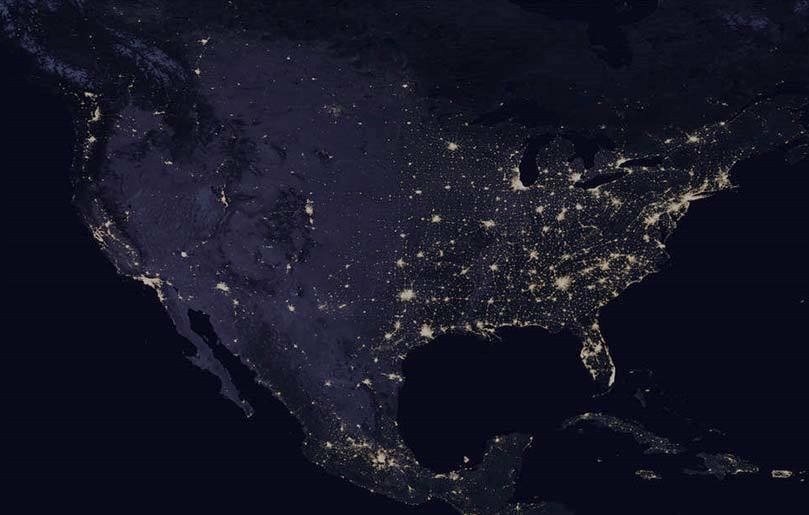
Composite image of continental United States at night in 2016. Image from Joshua Stevens using data from Miguel Román, NASA's Goddard Space Flight Center
6
*U.S. Department of Energy/U.S. Department of the Interior. 2016. National Offshore Wind Strategy: Facilitating the Development of the Offshore Wind Industry in the United States.
**U.S. Department of Energy/U.S. Department of the Interior. 2016. National Offshore Wind Strategy: Facilitating the Development of the Offshore Wind Industry in the United States.
OFFICE OF ENERGY EFFICIENCY & RENEWABLE ENERGY
In addition, daily offshore wind speed profiles tend to correspond well to periods of high electricity demand by coastal cities, such that the strongest winds (and thus highest potential energy generation) correspond to the periods of greatest electricity demand.**
U.S. DEPARTMENT OF ENERGY
The technical potential of U.S. offshore wind is more than double the country's total electricity consumption.*
Block Island and Beyond: Offshore Wind in the United States
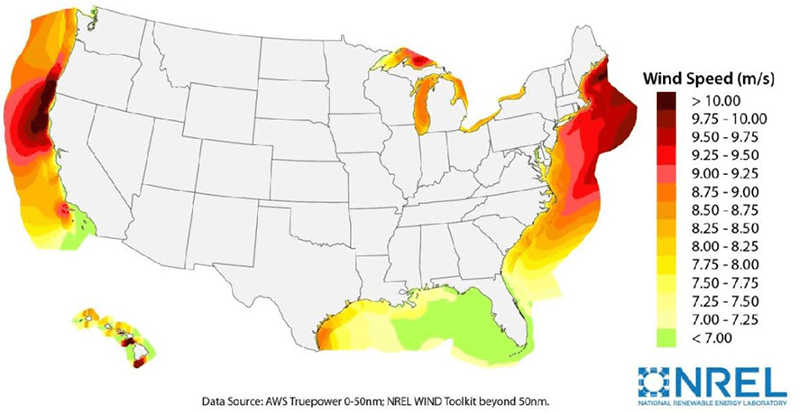
U.S. offshore wind resource data (100 m). Image from the National Renewable Energy Laboratory
7
*U.S. Department of Energy/U.S. Department of the Interior. 2016. National Offshore Wind Strategy: Facilitating the Development of the Offshore Wind Industry in the United States.
**U.S. Department of Energy. 2011. National Offshore Wind Strategy: Creating an Offshore Wind Industry in the United States.
OFFICE OF ENERGY EFFICIENCY & RENEWABLE ENERGY
Developing this resource can provide multiple revenue sources to local economies in the form of lease payments, tax payments, and local spending during construction.*
U.S. DEPARTMENT OF ENERGY
Offshore wind supports economic and energy diversification and growth.
Block Island and Beyond: Offshore Wind in the United States
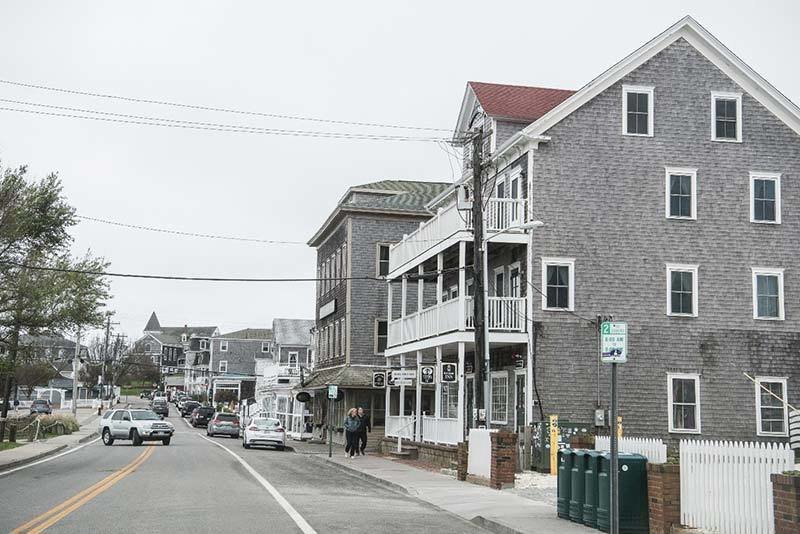
With a year-round population of just more than 1,000, Block Island, Rhode Island has seen the economic impact of the country's first offshore wind farm. Photo by Dennis Schroeder, NREL 40489
8
*WINDExchange. Wind Energy's Economic Impacts to Communities.
OFFICE OF ENERGY EFFICIENCY & RENEWABLE ENERGY
U.S. DEPARTMENT OF ENERGY
Offshore wind installations feature turbines that are larger than their onshore counterparts to efficiently harvest energy from the strong, unobstructed ocean winds.
Block Island and Beyond: Offshore Wind in the United States
*National Renewable Energy Laboratory. 2020. 2019 Offshore Wind Technology Data Update.
9
Globally, the capacity-weighted average offshore wind turbine size has grown from 3.5 MW in 2010 to 6 MW in 2019.
Similarly, rotor diameters have grown from a capacity-weighted average of 100 m in 2010 to 150 m in 2019. Announced turbine supply agreements for projects to be installed by 2025 show an increase in capacity to 10 MW and rotor diameter to 200 m.*
OFFICE OF ENERGY EFFICIENCY & RENEWABLE ENERGY
U.S. DEPARTMENT OF ENERGY
Different technologies are required depending on where the project is located.
Block Island and Beyond: Offshore Wind in the United States
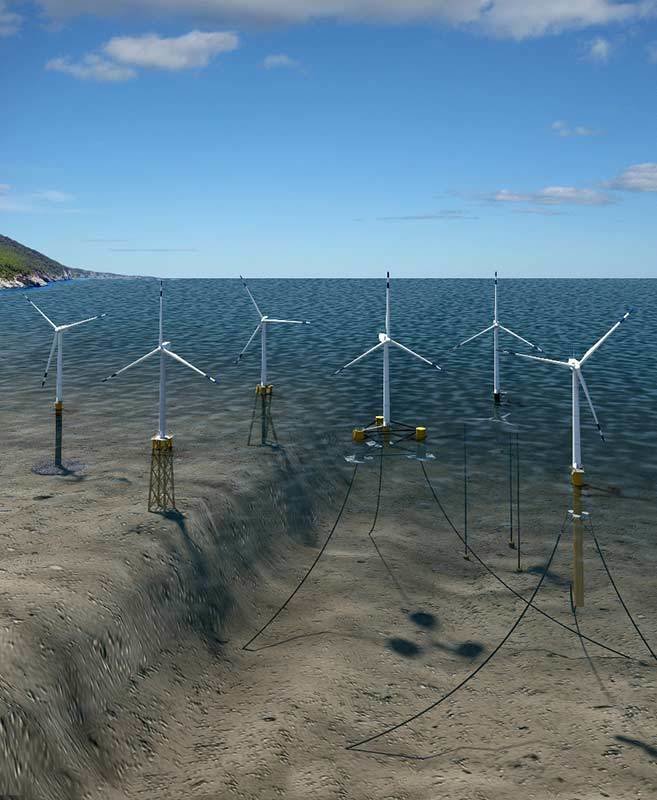
This graphic shows the different technologies that will be necessary for offshore deployment. Image by the National Renewable Energy Laboratory, NREL 49055
10
*Wiebe, Jamie. October 30, 2017. America's Wind Energy Future Looks Seaward. National Renewable Energy Laboratory.
Atlantic waters are typically shallower than the Pacific, allowing for the installation of fixed bottom projects that are either drilled or held into the seabed by gravity. This technology is currently used in a majority of deployed projects. The deeper waters of the Pacific will require different technology in the form of floating platforms that are just beginning to be used in European deployments.*
OFFICE OF ENERGY EFFICIENCY & RENEWABLE ENERGY
U.S. DEPARTMENT OF ENERGY
The distance from land determines whether a project falls under state and/or federal jurisdiction.
Block Island and Beyond: Offshore Wind in the United States
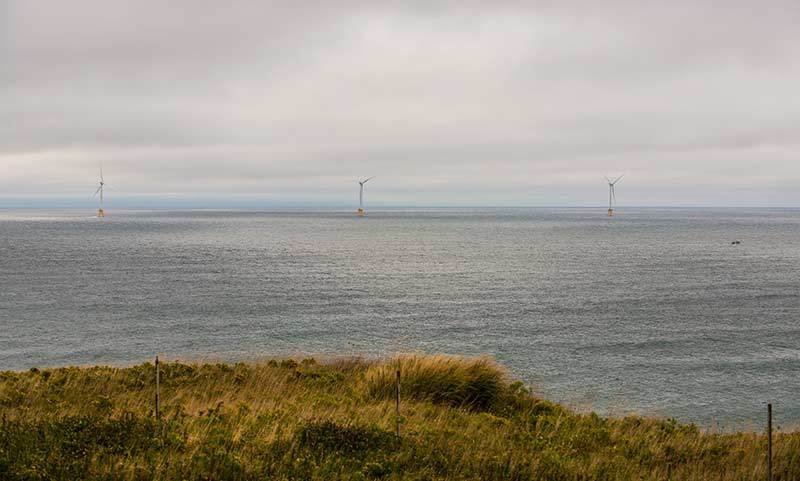
An onshore view of the Block Island Wind Farm. The project is located in state waters approximately three miles off the southeastern coast of the island. Photo by Dennis Schroeder, NREL 40475
11
*U.S. Energy Information Administration. December 2, 2016. Federal leasing for offshore wind grows as first U.S. offshore wind farm comes online.
State waters typically extend out to three nautical miles from shore, while federal waters extend out to 200 nautical miles.*
OFFICE OF ENERGY EFFICIENCY & RENEWABLE ENERGY
U.S. DEPARTMENT OF ENERGY
Presently, offshore wind turbines are imported from Europe.
Block Island and Beyond: Offshore Wind in the United States
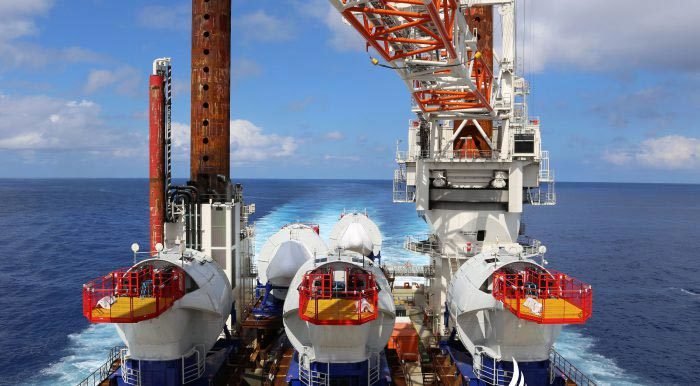
Block Island Wind Farm's nacelles being transported from overseas to the project. Photo from Deepwater Wind
12
*Maples et al. 2013. Installation, Operation, and Maintenance Strategies to Reduce the Cost of Offshore Wind Energy. National Renewable Energy Laboratory.
Until offshore wind component manufacturing in the United States expands, developers must rely on importing components from other countries with active offshore wind manufacturing capabilities. Local manufacturing is expected to expand along with the U.S. offshore wind industry. Heavy-lift cargo vessels are used to transport components from the place of origin.*
OFFICE OF ENERGY EFFICIENCY & RENEWABLE ENERGY
U.S. DEPARTMENT OF ENERGY
Offshore wind project construction requires:
Block Island and Beyond: Offshore Wind in the United States
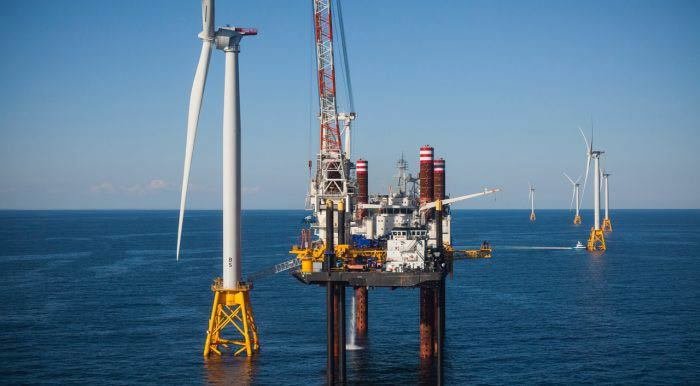
Blade installation using a jack-up vessel at the Block Island Wind Farm. Jack-up vessels are self-propelled or towed floating platforms that can be raised and lowered at offshore locations.** Photo from Deepwater Wind
13
*Maples et al. 2013. Installation, Operation, and Maintenance Strategies to Reduce the Cost of Offshore Wind Energy. National Renewable Energy Laboratory.
**Douglas Westwood. 2013. Assessment of Vessel Requirements for the U.S. Offshore Wind Sector. Prepared for the U.S. Department of Energy.
- Staging and onshore assembly areas for turbine storage and component assembly
- Offshore barges and seagoing tugs to transport foundations and project components
- A jack-up vessel to install the turbine tower, nacelle, hub, and blades
- A harbor facility for vessel storage during construction
- A cable-laying vessel for cable installation
- A horizontal drilling rig and dive support team for landfall cable installation
- Ocean-going tugs and crew vessels to transport equipment and workers.*
OFFICE OF ENERGY EFFICIENCY & RENEWABLE ENERGY
U.S. DEPARTMENT OF ENERGY
Examples from Block Island show that offshore wind can provide benefits to states and local communities. The following slides explore these benefits.
Block Island and Beyond: Offshore Wind in the United States
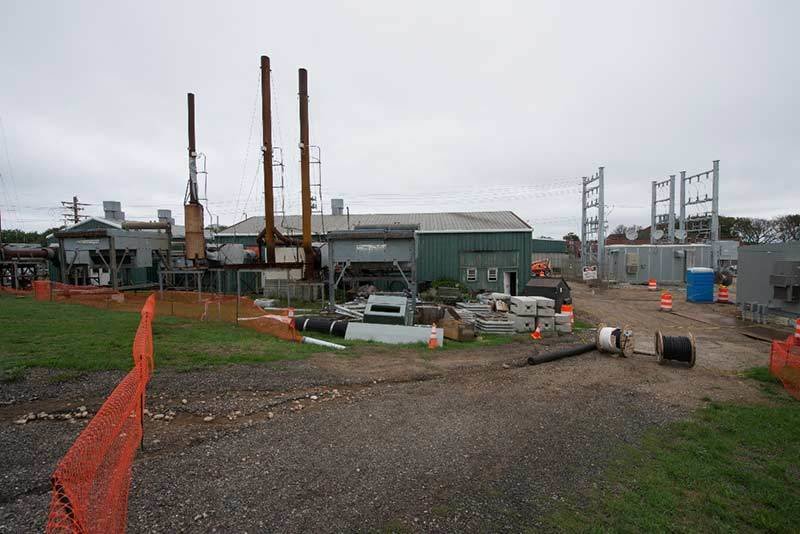
New infrastructure at the Block Island Power Company to support the Block Island Wind Farm is sited next to the island's old diesel power plant. Photo by Dennis Schroeder, NREL 40458
14
*Shuman, Cassius. May 1, 2017. Island operating on wind farm power. Block Island Times.
**U.S. Energy Information Administration. Electric Power Monthly. Average Price of Electricity to Ultimate Customers. Accessed July 2, 2018.
Long-term, stable energy costs
Prior to the completion of the Block Island Wind Farm, the town relied on diesel generation and nearly 1 million gallons of fuel annually to produce energy. In 2008, fuel costs for the generators drove electrical costs to more than 60 cents per kilowatt-hour* (more than 5x the national average for that time).**
OFFICE OF ENERGY EFFICIENCY & RENEWABLE ENERGY
U.S. DEPARTMENT OF ENERGY
Block Island and Beyond: Offshore Wind in the United States
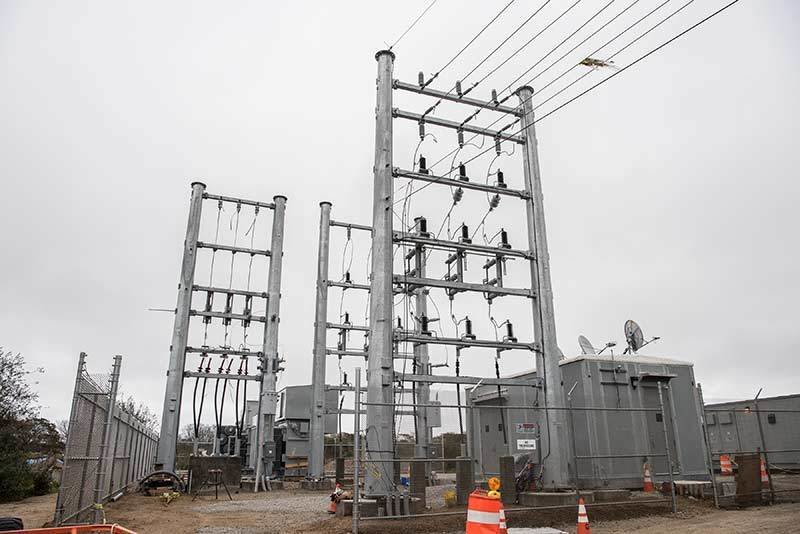
A new switching station was constructed as part of the Block Island Wind Farm project. Photo by Dennis Schroeder, NREL 40488
15
*U.S. Department of Energy. 2017. 2016 Offshore Wind Technologies Market Report.
**Lillian, Betsy. August 2, 2018. Vineyard Wind, Utilities File $65/MWh Contract Plans With MA Regulators. North American Windpower.
Long-term, stable energy costs
The price of electricity from the Block Island Wind Farm begins at ~24 cents per kilowatt-hour in the first year and ends at ~48 cents per kilowatt-hour in year 20.* These prices are a result of Block Island being the first project in U.S.
waters and the required infrastructure upgrades (transmission, substation, etc.). Smaller demonstration projects can have difficulties achieving economies of scale that can drastically lower prices. The costs of offshore wind energy from larger projects, such as the Vineyard Wind project, are expected to be less.**
OFFICE OF ENERGY EFFICIENCY & RENEWABLE ENERGY
U.S. DEPARTMENT OF ENERGY
Block Island and Beyond: Offshore Wind in the United States
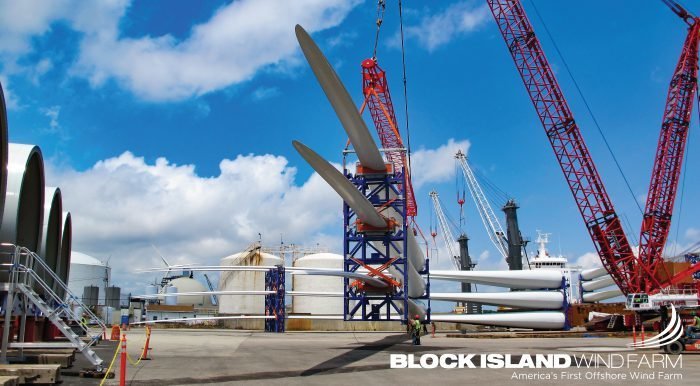
Unloading blades for the Block Island Wind Farm. Photo from Deepwater Wind
16
* Deepwater Wind: Block Island Wind Farm. Accessed July 2, 2018.
Construction and assembly jobs
During the two-year installation, more than 300 local workers were hired to develop, build, and commission the Block Island Wind Farm. More than 30 local companies were contracted to work on the project.*
OFFICE OF ENERGY EFFICIENCY & RENEWABLE ENERGY
U.S. DEPARTMENT OF ENERGY
Block Island and Beyond: Offshore Wind in the United States

Workers sit at the counter of Bethany’s Airport Diner. Photo by K. Curtis/Block Island Times
17
*McLeish, Todd. July 1, 2016. Wind powered: South County businesses get a lift from the Block Island Wind Farm. South County Life Magazine.
Increased demand for local housing and goods during construction period
During construction, many local businesses experienced increased demand for goods and services. For example, J.H. Lynch & Sons, one of the 30-plus companies working on the project, contracted Bethany's Airport Diner, a 25-year-old Block Island restaurant, to provide two meals per day to ~20 workers.*
OFFICE OF ENERGY EFFICIENCY & RENEWABLE ENERGY
U.S. DEPARTMENT OF ENERGY
Block Island and Beyond: Offshore Wind in the United States
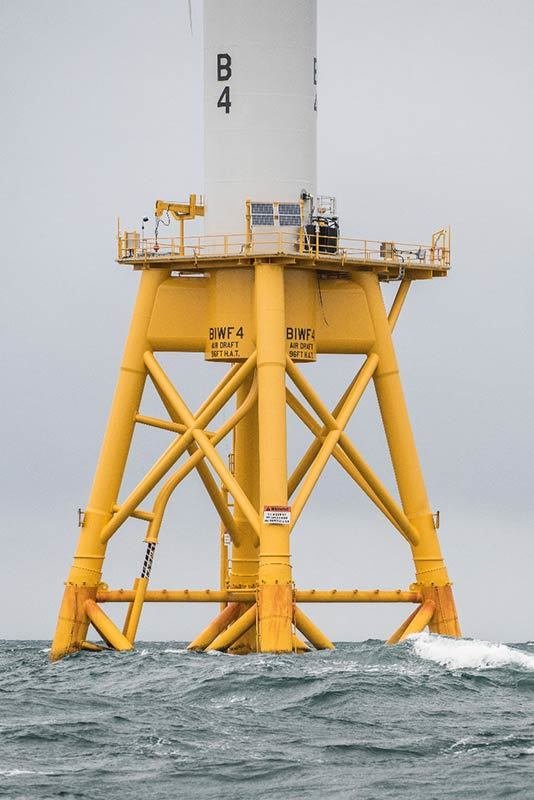
A Block Island turbine's foundation and lower tower. Photo by Dennis Schroeder, NREL 40465
18
*Rhode Island Coastal Resources Management Council. November 17, 2014. CRMC Council approves final DWW permits.
Revenue for federal, state, and local governments
Since the project is located in state waters, Deepwater Wind is required to pay an annual lease payment of $150,000 to the state through the Rhode Island Coastal Resource Management Council for the turbines and cable. The money is added to the state's General Fund. The deal runs through the 25th anniversary of the commercial operating commencement date.*
OFFICE OF ENERGY EFFICIENCY & RENEWABLE ENERGY
U.S. DEPARTMENT OF ENERGY
Block Island and Beyond: Offshore Wind in the United States
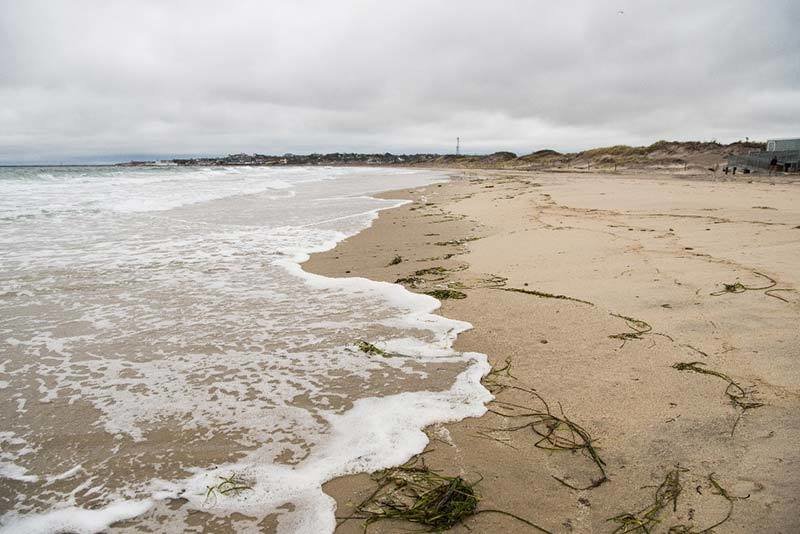
Shore view of Block Island. Photo by Dennis Schroeder, NREL 40486
19
*Island Institute. December 2015. Engaging Communities in Offshore Wind: Case Studies and Lessons Learned from New England Islands.
Community benefit agreements that compensate local communities for project impacts
Block Island officials hired consultants to represent the community during negotiations with developers. The developers reimbursed the town for the cost of the consultants, who negotiated to have fiber optic strands included in the electricity cable bundle provided for the town. (Fiber optic strands will provide the necessary infrastructure for the town to establish a broadband network on the island.) Deepwater Wind and New Shoreham, the municipal entity on Block Island, also agreed to have the wind farm company pay for improvements to town infrastructure where the cable comes ashore.*
OFFICE OF ENERGY EFFICIENCY & RENEWABLE ENERGY
U.S. DEPARTMENT OF ENERGY
Stakeholder collaboration and engagement were key to the success of the Block Island project.
Block Island and Beyond: Offshore Wind in the United States
20
Focusing on early engagement can provide an avenue for mutual learning through available and appropriate information (and educational opportunities) that can influence the social acceptance of a project. Block Island stakeholders and decision makers included:
- Army Corps of Engineers
- U.S. Federal Aviation Administration
- Bureau of Ocean Energy Management
- U.S. Fish and Wildlife Service
- National Oceanic and Atmospheric Administration
- National Marine Fisheries Service
- U.S. Environmental Protection Agency
- U.S. Coast Guard
- Rhode Island Coastal Resource Management Council
- Rhode Island Public Utilities Commission
- Rhode Island Department of Environmental Management
- Rhode Island Department of Transportation
- Rhode Island State Properties Committee
- New Shoreham Electric Utility Task Group
- New Shoreham Planning Board
- New Shoreham Historic District Commission
- New Shoreham Zoning Board of Review
- New Shoreham Town Council
- And of course, developer Deepwater Wind.
OFFICE OF ENERGY EFFICIENCY & RENEWABLE ENERGY
U.S. DEPARTMENT OF ENERGY
Challenges to offshore wind energy development in the United States include:
Block Island and Beyond: Offshore Wind in the United States
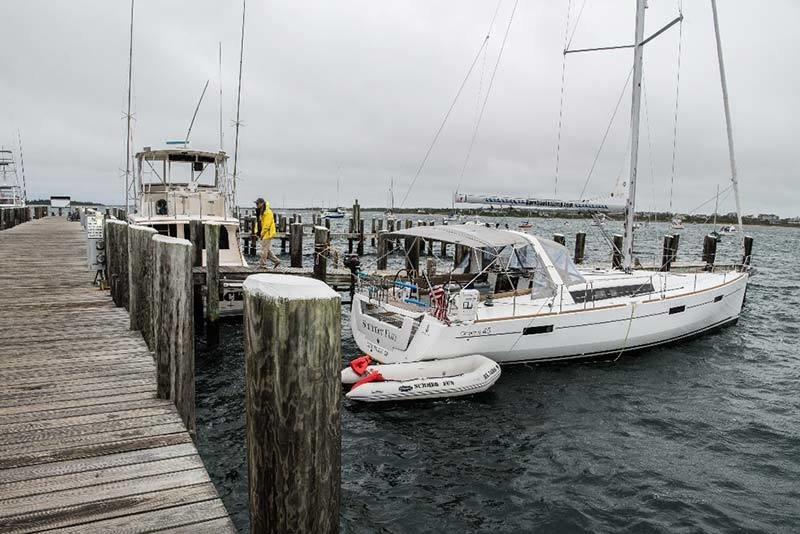
A dock on Block Island. NREL Flickr
21
*Mills et al. 2018. Estimating the Value of Offshore Wind Along the United States' Eastern Coast. Lawrence Berkeley National Laboratory.
- High construction and component costs
- Current demand and prices related to alternative resources (including natural gas, onshore wind, and solar photovoltaics)
- A complex and lengthy regulatory process for planning and siting
- A lack of pre-existing infrastructure to manage construction at low cost
- Impacts on existing industries (tourism, fishing)
- Mitigating potential impacts on wildlife.
OFFICE OF ENERGY EFFICIENCY & RENEWABLE ENERGY
U.S. DEPARTMENT OF ENERGY
The U.S. Department of Energy (DOE) has allocated more than $200 million to offshore wind research and development projects for technology development and market barriers, as well as advanced technology demonstration.
Block Island and Beyond: Offshore Wind in the United States
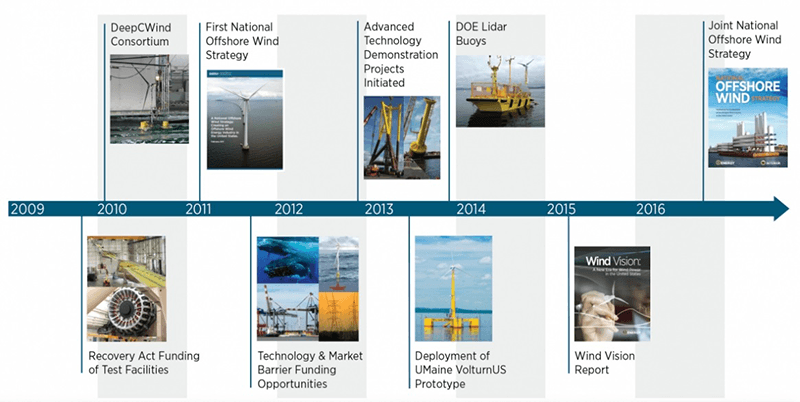
22
*U.S. Department of Energy. 2017. Offshore Wind Initiatives at the U.S. Department of Energy.
DOE-funded offshore wind technology development projects have focused on developing the engineering modeling and analysis tools needed to reduce costs
and designing the next generation of offshore wind technologies, including optimized turbines and foundations.*
OFFICE OF ENERGY EFFICIENCY & RENEWABLE ENERGY
U.S. DEPARTMENT OF ENERGY
DOE also invests in projects to mitigate market barriers to offshore wind deployment, including efforts such as:
Block Island and Beyond: Offshore Wind in the United States
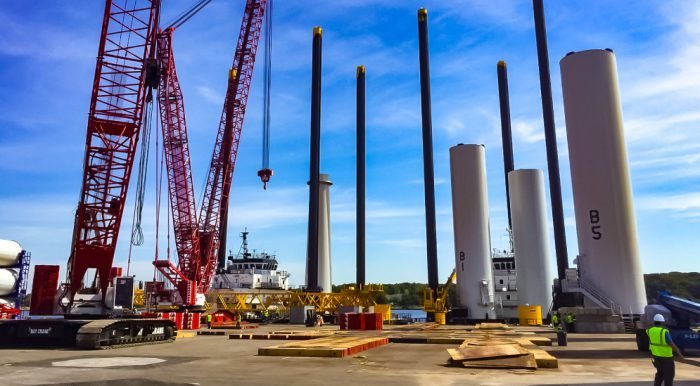
Components for the Block Island Wind Farm being unloaded. Photo from Deepwater Wind
23
*U.S. Department of Energy. 2017. Offshore Wind Initiatives at the U.S. Department of Energy.
Integrating offshore wind energy into existing grid infrastructure; limiting the extent to which offshore wind turbines interact with avian and aquatic life; and ensuring that the construction of offshore wind is feasible through the study of our nation’s available ports, vessels, and supply chain infrastructure.*
OFFICE OF ENERGY EFFICIENCY & RENEWABLE ENERGY
U.S. DEPARTMENT OF ENERGY
In December 2017, DOE announced an investment of $20.5 million in a research and development consortium focusing on reducing the cost of offshore wind.
Block Island and Beyond: Offshore Wind in the United States
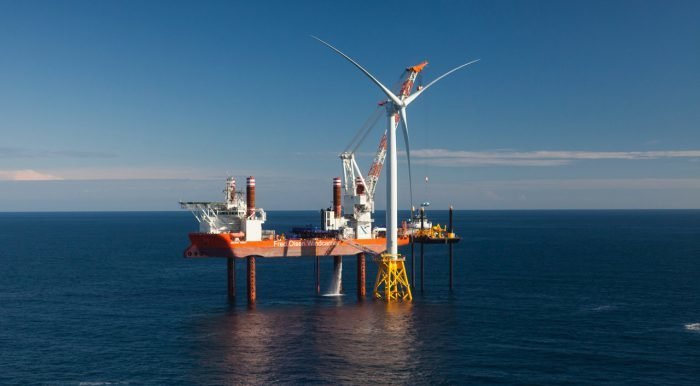
Construction of the Block Island Wind Farm. Photo from Deepwater Wind
24
The consortium is a cooperative public-private partnership focusing on topics such as wind power technology, resource and physical site characterization, installation, and operations.
In June 2018, DOE announced the selection of the New York State Energy Research and Development Authority (NYSERDA) to administer the program. NYSERDA is also providing $20.5 million, matching the DOE investment.
OFFICE OF ENERGY EFFICIENCY & RENEWABLE ENERGY
U.S. DEPARTMENT OF ENERGY
Since the installation of the Block Island Wind Farm, offshore wind has continued to gain momentum in the United States with multiple project announcements that exemplify the bright future for this industry.
Block Island and Beyond: Offshore Wind in the United States
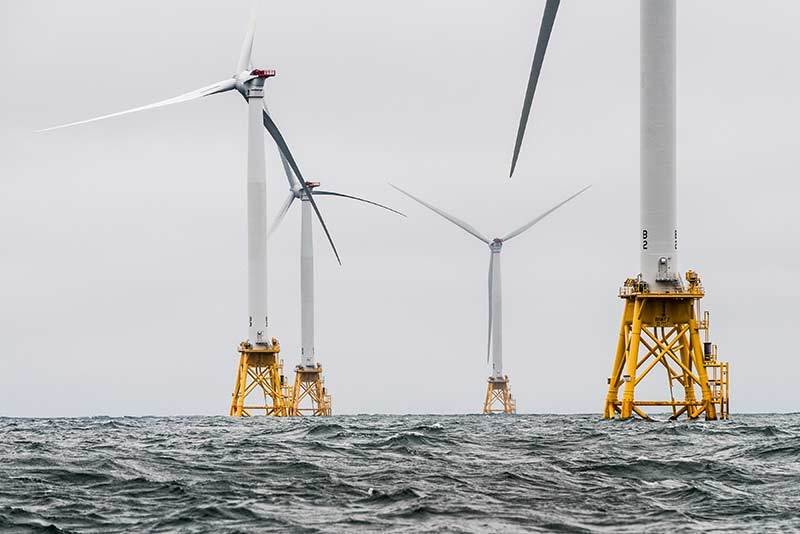
Four of the five turbines that make up the Block Island Wind Farm. Photo from Dennis Schroeder, NREL 40455
25
More details about offshore wind energy can be found on the WINDExchange website, DOE's Offshore Wind Research and Development pages, and in the 2019 Offshore Wind Technology Data Update.